In a world of unpredictable financial markets, global unrest, and inflationary pressures, investors often turn to precious metals as a haven for their wealth. Among these, gold and silver reign supreme. But when it comes down to choosing between the two—Gold vs Silver: Which is Better as an Investment?—the answer isn’t as straightforward as one might think.
Both metals have historically safeguarded wealth, preserved purchasing power, and served as excellent hedging tools during economic downturns. But they differ in volatility, liquidity, affordability, industrial demand, and storage considerations.
Let’s dive deep and explore the nuances that separate these two glittering investment options.

Precious Metals in Times of Crisis
Gold and silver have both proven their mettle in times of financial crisis:
- 1991: India pledged gold to overcome a severe balance of payments crisis.
- 2008: During the Lehman Brothers collapse and global recession, gold rallied while most equities crashed.
- 2020 and Beyond: Amid the COVID-19 pandemic and subsequent global slowdown, both metals surged, reminding investors of their role as reliable stores of value.
But while both metals have shone during downturns, their behavior under pressure—and under prosperity—is starkly different.
Volatility: The Risk-Return Balance
Silver has long been known for its high volatility. Its prices can swing sharply due to its dual role as both a precious and industrial metal.
- Demand-Supply Tug: Silver is heavily used in industrial applications—from electronics to solar panels—making its price more sensitive to economic activity. A dip in manufacturing can pull silver prices down sharply.
- Smaller Market Size: The global silver market is relatively small compared to gold. Even minor fluctuations in demand or supply can cause outsized price movements.
Gold, on the other hand, is traditionally more stable:
- Its demand is driven by central banks, investors, and jewellery, making it less cyclical.
- As a pure hedge against inflation and geopolitical risks, gold maintains a more consistent upward trajectory during uncertain times.
Verdict: For risk-averse investors, gold offers a smoother ride. For those willing to stomach higher volatility for potentially bigger gains, silver may be more appealing.
Liquidity: Ease of Buying and Selling
Both gold and silver are highly liquid assets, but gold has a slight edge:
- Gold enjoys stronger institutional demand and is actively traded in larger volumes across the world.
- Silver, while also traded globally, may have slightly wider bid-ask spreads, especially during high volatility.
Verdict: Gold wins the liquidity round, making it a more favorable choice for investors looking for swift entry and exit.
Demand: Industrial vs Cultural
Gold:
- Dominates the jewellery sector, especially in India where weddings and festivals drive massive consumption.
- Used in electronics and medical applications, albeit to a lesser extent.
Silver:
- Nearly 60% of silver demand comes from industrial sectors like:
- Electronics
- Automotive
- Renewable energy (especially solar panels)
- Medicine
- This industrial use means silver is more economically sensitive. When economies slow down, silver demand contracts.
Verdict: Gold enjoys more stable, consistent demand, while silver’s demand is cyclical and closely tied to industrial output.
Storage: Size and Maintenance Matter
Storage is a critical factor in physical investment:
- Silver is bulkier. At current rates, the same investment amount buys significantly more silver by weight, making it harder to store.
- It is also denser and more prone to tarnishing, requiring special climate-controlled storage, increasing maintenance costs.
- Gold, being more valuable per unit weight, is easier to store securely and needs minimal maintenance.
Verdict: Gold is more storage-efficient and cost-effective for long-term physical holders.
Affordability and Accessibility
Silver is known as the “poor man’s gold,” and rightfully so:
- With silver trading at a fraction of gold’s price, small investors can gain exposure with lower capital.
- The gold-to-silver ratio, which currently stands at 120:1, illustrates that gold is 120 times more valuable than silver per ounce.
Verdict: Silver is more affordable, making it an ideal entry point for new or small-scale investors.
Government Stockpiles and Strategic Importance
- Gold is a strategic asset held in reserves by central banks globally. It plays a direct role in currency valuation and international economic stability.
- Silver, though valuable, is rarely held as a national reserve asset. It lacks the global institutional backing that gold enjoys.
Verdict: Gold is a globally recognized reserve asset with strategic importance; silver is not.
Modern Investment Avenues
Investment in precious metals has evolved beyond buying coins and bars:
- Gold ETFs, sovereign gold bonds, digital gold, and gold futures have made gold more accessible and liquid for modern investors.
- Silver ETFs and silver exchanges are also being developed, promising similar ease of investment in the near future.
Government Initiatives:
- India has launched gold hallmarking, gold exchanges, and introduced sovereign gold bonds—all initiatives that enhance gold’s investment ecosystem.
- Silver is expected to catch up with new investment vehicles being rolled out.
Verdict: Gold has a more developed and supportive ecosystem for investors, but silver is catching up quickly.
So, Gold or Silver: Which Should You Choose?
Here’s a side-by-side snapshot:
| Factor | Gold | Silver |
|---|---|---|
| Volatility | Low | High |
| Liquidity | High | Moderate to High |
| Industrial Demand | Moderate | High |
| Storage | Compact and easy | Bulky, needs climate control |
| Affordability | Expensive | Affordable |
| Taxation & Regulation | Extensive framework | Growing framework |
| Strategic Role | Held by central banks | Not held in reserves |
Final Thoughts: Your Investment Decision
- If you prefer stability, long-term wealth preservation, and institutional-grade safety, gold is your best bet.
- If you’re looking for affordable entry, high upside potential, and can handle market volatility, silver might serve you well.
Ultimately, the best strategy could involve a diversified portfolio that includes both gold and silver. Each metal has its unique strengths, and combining them can offer both stability and growth potential.











